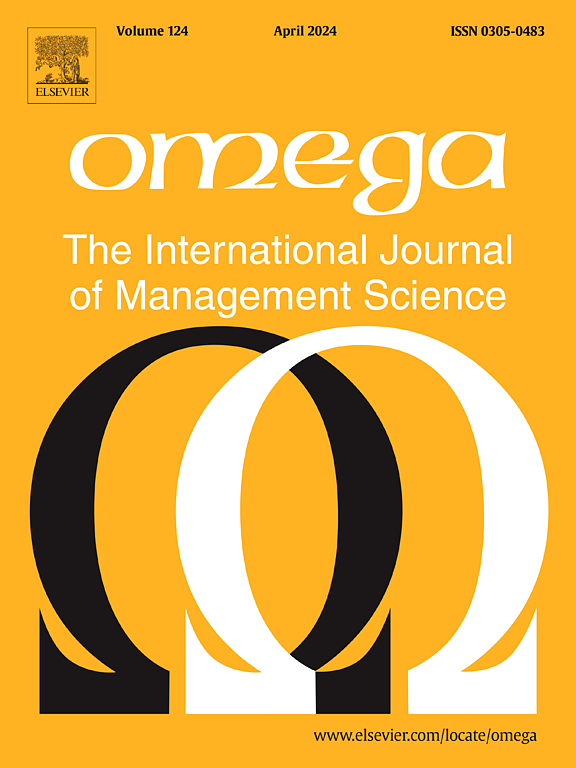A mixed integer programming approach to address cumulative threats in multi action management plans for biodiversity recovery
IF 7.2
2区 管理学
Q1 MANAGEMENT
Omega-international Journal of Management Science
Pub Date : 2025-01-28
DOI:10.1016/j.omega.2025.103282
引用次数: 0
Abstract
Traditionally, most of the prioritization models used by researchers and practitioners, rely on spatially dichotomous settings for threats, for species and for actions’ benefit; i.e., threats and species are present with equal intensity in some territorial units (while in the other units are not present at all), and actions have impact only on those units where they are applied. However, when dealing with ecological phenomena on large and complex territories, characterized by different areas (such as multiple realms or large river basins) and different spatial connectivity patterns among them, such a dichotomous setting does not capture the spatial (cumulative) diffusion of threats and thus actions’ benefits. Hence, common conservation planning tools are likely to misestimate the benefits of actions and the impact of threats, yielding less effective solutions. In order to address this issue, we develop a framework for designing multi-action prioritization plans featuring threats and actions’ benefit spatial diffusion. Our framework relies on a mathematical programming model that identifies priority areas for the implementation of management actions for multiple threats across a complex and large landscape. We consider the particular case an ecological setting characterized by different realms, multiple threats, and multiple species. We use the Tagus River (Iberian Peninsula) as a case study, including four realms (terrestrial, freshwater, estuary, and marine), where we integrate three different types of spatial connectivity: longitudinal along rivers, and multidimensional in the estuary and marine realms. We simulate the spatial diffusion of threats across the study area using four types of decay models (dispersal kernels): one exponential kernel, two negative triangular kernels (medium and high), and no dispersal. The results show how the MIP-based methodology offers a flexible and practical strategy for incorporating the cumulative effects of threats into action management planning. Furthermore, the primal-MIP heuristic was demonstrated to be a noteworthy alternative for finding good bounds of the original MIP model.
生物多样性恢复多行动管理计划中累积威胁的混合整数规划方法
传统上,研究人员和实践者使用的大多数优先级模型依赖于威胁、物种和行动效益的空间二元设置;例如,威胁和物种在某些领土单元中以同等强度存在(而在其他单元中根本不存在),并且行动只对它们所应用的单元产生影响。然而,当处理大而复杂的领土上的生态现象时,以不同的区域(如多个领域或大流域)和它们之间不同的空间连接模式为特征,这种二分设置无法捕捉到威胁的空间(累积)扩散,从而无法捕捉到行动的利益。因此,常见的保护规划工具可能会错误地估计行动的好处和威胁的影响,从而产生不太有效的解决方案。为了解决这一问题,我们开发了一个框架,用于设计具有威胁和行动利益空间扩散的多行动优先级计划。我们的框架依赖于一个数学规划模型,该模型确定了在复杂和大型景观中实施多种威胁的管理行动的优先领域。我们考虑了一个特殊的生态环境,其特点是不同的领域,多种威胁,和多物种。我们以塔霍河(伊比利亚半岛)为例,包括四个领域(陆地、淡水、河口和海洋),在这里我们整合了三种不同类型的空间连通性:纵向沿河流,以及多维的河口和海洋领域。我们使用四种类型的衰减模型(扩散核)来模拟威胁在研究区域的空间扩散:一个指数核、两个负三角形核(中、高)和无扩散。结果表明,基于mip的方法为将威胁的累积影响纳入行动管理规划提供了一种灵活和实用的战略。此外,原始MIP启发式被证明是寻找原始MIP模型良好边界的值得注意的替代方法。
本文章由计算机程序翻译,如有差异,请以英文原文为准。
求助全文
约1分钟内获得全文
求助全文
来源期刊

Omega-international Journal of Management Science
管理科学-运筹学与管理科学
CiteScore
13.80
自引率
11.60%
发文量
130
审稿时长
56 days
期刊介绍:
Omega reports on developments in management, including the latest research results and applications. Original contributions and review articles describe the state of the art in specific fields or functions of management, while there are shorter critical assessments of particular management techniques. Other features of the journal are the "Memoranda" section for short communications and "Feedback", a correspondence column. Omega is both stimulating reading and an important source for practising managers, specialists in management services, operational research workers and management scientists, management consultants, academics, students and research personnel throughout the world. The material published is of high quality and relevance, written in a manner which makes it accessible to all of this wide-ranging readership. Preference will be given to papers with implications to the practice of management. Submissions of purely theoretical papers are discouraged. The review of material for publication in the journal reflects this aim.
 求助内容:
求助内容: 应助结果提醒方式:
应助结果提醒方式:


